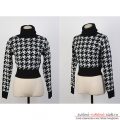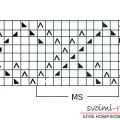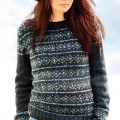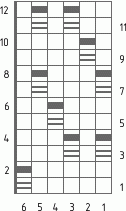
How to master two-color knitting with knitting needles, openwork bicolour patterns, "lazy" bicolour patterns, as well as two-color patterns for children and adults with diagrams and detailed descriptions.
Learning to knit two-color patterns with knitting needles: schemes, photos and description Two-color patterns will be a good solution for creating original products. They, most often, you can tie a sweater, jacket, hat or scarf. In our article you will find several schemes of two-color patterns with detailed description. Please note that most of the proposed patterns are one-sided. This article will help you to make sure that the bicolour patterns look great and are able to diversify your wardrobe. So, let's begin. Two-color pattern number 1 This pattern is very tight and can keep shape well. When performing, you will need special attention and patience: it is very important not to overtake those loops that need to have an extended appearance. However, the finished product created by this pattern is worth the effort. Applying this two-color pattern, you can create a coat or sweater. To make a sample, you need to make a set of the number of loops, which will be a multiple of eight, plus 2 more loops to ensure the symmetry of the whole pattern. Do not forget about the 2 edge tabs. 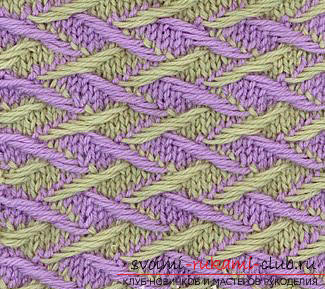 First row (green thread): we sew each eyelet. The second row (green thread): we sew each loops back. The third row (lilac thread): we knit one facial, and then follows the repeating part of the figure: we remove four loops on the right needle with the left one, without tying them, the thread is in front of the working cloth, create four facial loops. We finish the row with one taken off unbroken loop, while the main thread is in front of the canvas. The fourth row (lilac thread): we knit one purl, and then follows the repeating part of the picture: create three purl loops, remove the four loops with a string behind the cloth, we sew one purl. We end the series with one of the wrong loops. The fifth row (lilac thread): we knit one facial, and then follows the repeating part of the picture: create two facial loops, remove four loops with a thread in front of the main cloth, we sew the 2nd facial. We conclude row 1 with a face loop. The sixth row (lilac thread): we knit one wrong, and then follows the repeating part of the picture: we create one back strap, we remove four loops with a thread behind the cloth, we sew three purl. We end the series with one of the wrong loops. Seventh row (lilac thread): one eyelet should be removed with a thread in front of the canvas, and then follows the repeating part of the picture: create four facial loops, remove the four eyelets with a thread in front of the canvas. We finish the series with one face loop.
First row (green thread): we sew each eyelet. The second row (green thread): we sew each loops back. The third row (lilac thread): we knit one facial, and then follows the repeating part of the figure: we remove four loops on the right needle with the left one, without tying them, the thread is in front of the working cloth, create four facial loops. We finish the row with one taken off unbroken loop, while the main thread is in front of the canvas. The fourth row (lilac thread): we knit one purl, and then follows the repeating part of the picture: create three purl loops, remove the four loops with a string behind the cloth, we sew one purl. We end the series with one of the wrong loops. The fifth row (lilac thread): we knit one facial, and then follows the repeating part of the picture: create two facial loops, remove four loops with a thread in front of the main cloth, we sew the 2nd facial. We conclude row 1 with a face loop. The sixth row (lilac thread): we knit one wrong, and then follows the repeating part of the picture: we create one back strap, we remove four loops with a thread behind the cloth, we sew three purl. We end the series with one of the wrong loops. Seventh row (lilac thread): one eyelet should be removed with a thread in front of the canvas, and then follows the repeating part of the picture: create four facial loops, remove the four eyelets with a thread in front of the canvas. We finish the series with one face loop. 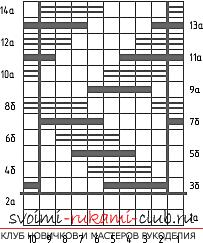 The eighth row (lilac thread): One loops need to be removed with a thread behind the canvas, and then the repeating part of the pattern follows: three loops need to be removed with a thread behind the cloth, then create four purl loops, one loops off with a thread behind the canvas. We finish the series with one removed loop with a thread behind the canvas. Ninth row (green thread): we knit one facial, and then follows the repeating part of the picture: create one face loop, remove four loops with a thread in front of the knitting cloth, we tie three facial ones. We finish the series with the 1st facial loop. The tenth row (green thread): one eyelet needs to be removed with a string behind the knitting cloth, and then the repeating part of the pattern follows: create four purl loops, remove four loops with a string behind the canvas. We end the series with one of the wrong loops. The eleventh row (green thread): one eyelet needs to be removed with a thread in front of the canvas, and then the repeating part of the pattern follows: three loops are removed with a thread in front of the cloth, four face loops, one eyelet is removed, the thread is in front of the cloth. We finish the series with one removed loop with a thread in front of the canvas. The twelfth row (green thread): one eyelet should be removed with a thread behind the cloth, and then the repeating part of the figure follows: two loops remove with a thread behind the cloth, then we sew the four backs, and again - two eyelets are removed with a thread behind the canvas. We finish the series with one removed loop with a thread behind the canvas. The thirteenth row (green thread): one eyelet needs to be removed with a thread in front of the canvas, and then the repeating part of the pattern follows: one eyelet needs to be removed with a thread in front of the fabric, then create four face loops, remove the three loops with the thread in front of the canvas. We finish the series with one removed loop with a thread in front of the canvas. The eighth row (green thread): we knit one purl, and then follows the repeating part of the picture: we remove four loops with a thread behind the cloth, create four purl loops. We finish the series with one removed loop with a thread behind the canvas. After this, proceed to repeat the pattern, starting with the 3rd row. Two-color pattern № 2 - "Bricks" This pattern can be used for making sweaters. To make a sample, it is necessary to make a set of the number of loops, which will be a multiple of six, plus one more loop to ensure the symmetry of the whole pattern. Do not forget about the two edge tabs. We use two colors of thread - burgundy and gray.
The eighth row (lilac thread): One loops need to be removed with a thread behind the canvas, and then the repeating part of the pattern follows: three loops need to be removed with a thread behind the cloth, then create four purl loops, one loops off with a thread behind the canvas. We finish the series with one removed loop with a thread behind the canvas. Ninth row (green thread): we knit one facial, and then follows the repeating part of the picture: create one face loop, remove four loops with a thread in front of the knitting cloth, we tie three facial ones. We finish the series with the 1st facial loop. The tenth row (green thread): one eyelet needs to be removed with a string behind the knitting cloth, and then the repeating part of the pattern follows: create four purl loops, remove four loops with a string behind the canvas. We end the series with one of the wrong loops. The eleventh row (green thread): one eyelet needs to be removed with a thread in front of the canvas, and then the repeating part of the pattern follows: three loops are removed with a thread in front of the cloth, four face loops, one eyelet is removed, the thread is in front of the cloth. We finish the series with one removed loop with a thread in front of the canvas. The twelfth row (green thread): one eyelet should be removed with a thread behind the cloth, and then the repeating part of the figure follows: two loops remove with a thread behind the cloth, then we sew the four backs, and again - two eyelets are removed with a thread behind the canvas. We finish the series with one removed loop with a thread behind the canvas. The thirteenth row (green thread): one eyelet needs to be removed with a thread in front of the canvas, and then the repeating part of the pattern follows: one eyelet needs to be removed with a thread in front of the fabric, then create four face loops, remove the three loops with the thread in front of the canvas. We finish the series with one removed loop with a thread in front of the canvas. The eighth row (green thread): we knit one purl, and then follows the repeating part of the picture: we remove four loops with a thread behind the cloth, create four purl loops. We finish the series with one removed loop with a thread behind the canvas. After this, proceed to repeat the pattern, starting with the 3rd row. Two-color pattern № 2 - "Bricks" This pattern can be used for making sweaters. To make a sample, it is necessary to make a set of the number of loops, which will be a multiple of six, plus one more loop to ensure the symmetry of the whole pattern. Do not forget about the two edge tabs. We use two colors of thread - burgundy and gray.  The first and seventh rows (gray thread): we sew each eyelet. The second and eighth rows (gray thread): we sew each loops back. The third row (maroon thread): we knit one front, and then follows a repeating pattern: three face loops, one eyelet to be removed, the thread is behind the main cloth, create two facial loops. Fourth and sixth rows (maroon thread): immediately follows a repeating pattern: two face loops, one eyelet must be removed without tying it, the thread must be in front of the cloth, create three facial loops. We conclude row 1 with a face loop. The fifth row (maroon thread): we knit one facial, and then follows the repeating part of the picture: 3 purl loops, 1 loop to be removed without tying it, the thread is behind the main cloth, create the 2nd purl loops. The ninth row (maroon thread): we knit one face, and then follows the repeating part of the picture: three face loops, one eyelet is removed without tying it, the thread is behind the canvas, create five facial loops. Tenth and twelfth rows (maroon thread): immediately follows a repeating pattern: five facial loops, one eyelet must be removed without tying it while the thread is in front of the knitting product. We conclude row 1 with a face loop.
The first and seventh rows (gray thread): we sew each eyelet. The second and eighth rows (gray thread): we sew each loops back. The third row (maroon thread): we knit one front, and then follows a repeating pattern: three face loops, one eyelet to be removed, the thread is behind the main cloth, create two facial loops. Fourth and sixth rows (maroon thread): immediately follows a repeating pattern: two face loops, one eyelet must be removed without tying it, the thread must be in front of the cloth, create three facial loops. We conclude row 1 with a face loop. The fifth row (maroon thread): we knit one facial, and then follows the repeating part of the picture: 3 purl loops, 1 loop to be removed without tying it, the thread is behind the main cloth, create the 2nd purl loops. The ninth row (maroon thread): we knit one face, and then follows the repeating part of the picture: three face loops, one eyelet is removed without tying it, the thread is behind the canvas, create five facial loops. Tenth and twelfth rows (maroon thread): immediately follows a repeating pattern: five facial loops, one eyelet must be removed without tying it while the thread is in front of the knitting product. We conclude row 1 with a face loop. 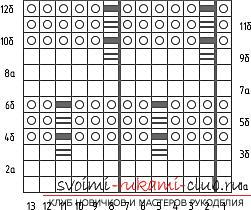 Eleventh row (maroon thread): we knit one wrong, and then follows the repeating part of the picture: one eyelet must be removed without tying it while the thread is behind the canvas, creating five purl loops. After this, repeat the pattern starting from the 1st row. Two-color pattern number 3 - "Lazy jacquard" To make a sample, you need to make a set of number of loops, which will be a multiple of six, plus 2 more edge tabs. We use two colors of thread - burgundy and gray. The first, fifth and seventh rows (maroon thread): we tie each eyelet. Second, sixth and tenth rows (maroon thread): we sew each loops back. The third row (gray thread) follows the repetition of the part of the pattern: one facial, one eyelet to be removed without tying it, the thread is behind the knitting product, create three facial loops, remove one loop without tying it, the thread is behind the knitting thread product.
Eleventh row (maroon thread): we knit one wrong, and then follows the repeating part of the picture: one eyelet must be removed without tying it while the thread is behind the canvas, creating five purl loops. After this, repeat the pattern starting from the 1st row. Two-color pattern number 3 - "Lazy jacquard" To make a sample, you need to make a set of number of loops, which will be a multiple of six, plus 2 more edge tabs. We use two colors of thread - burgundy and gray. The first, fifth and seventh rows (maroon thread): we tie each eyelet. Second, sixth and tenth rows (maroon thread): we sew each loops back. The third row (gray thread) follows the repetition of the part of the pattern: one facial, one eyelet to be removed without tying it, the thread is behind the knitting product, create three facial loops, remove one loop without tying it, the thread is behind the knitting thread product. 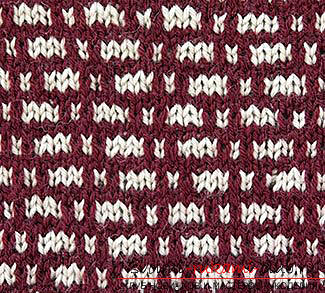 Fourth (gray thread): immediately follows the repetition of the part of the pattern: one loops are removed without tying it, the thread is in front of the knitting product, we create three face loops, one loop should be removed without tying it, the thread is in front of the knitting product, creating one wrong. Seventh row (gray thread): immediately repeat the part of the pattern: one loops are removed without tying it, the thread is behind the knitting product, we create one face loop, 1 loop must be removed without tying it, the thread is behind the knitting product , create 3 facial loops. The eighth row (gray thread): immediately repeat the part of the pattern: 3 purl loops, 1 loop to remove without threading it, thread is in front of the knitting cloth, create one back loop, remove one loop without tying it, thread is in front of the knitting cloth. The tenth one (gray thread): immediately follows the repeating part of the picture: one loops are removed without tying it, the thread is behind the knitting cloth, then we create three face loops, we remove one loop without tying it, the thread is behind the knitting cloth, create 1 face loop.
Fourth (gray thread): immediately follows the repetition of the part of the pattern: one loops are removed without tying it, the thread is in front of the knitting product, we create three face loops, one loop should be removed without tying it, the thread is in front of the knitting product, creating one wrong. Seventh row (gray thread): immediately repeat the part of the pattern: one loops are removed without tying it, the thread is behind the knitting product, we create one face loop, 1 loop must be removed without tying it, the thread is behind the knitting product , create 3 facial loops. The eighth row (gray thread): immediately repeat the part of the pattern: 3 purl loops, 1 loop to remove without threading it, thread is in front of the knitting cloth, create one back loop, remove one loop without tying it, thread is in front of the knitting cloth. The tenth one (gray thread): immediately follows the repeating part of the picture: one loops are removed without tying it, the thread is behind the knitting cloth, then we create three face loops, we remove one loop without tying it, the thread is behind the knitting cloth, create 1 face loop.  Twelfth row (gray thread): immediately follows the repeating part of the picture: 1 purl loop, 1 loop off, without tying it at the same time, the thread is in front of the knitting cloth, create three purl loops, remove one loop without tying it, the thread is in front of the knitting cloth. After this, repeat the pattern starting from the 1st row. Two-color pattern number 4 - another "lazy jacquard." To create it, you can use both thin and thick threads. To make a sample, it is necessary to carry out a set of number of loops, which will be a multiple of six, plus two more edge tabs. We use two colors of thread - green and white. The first row (white thread) is a repeating part of the picture: five facial loops, one loop should be removed without tying it while the thread is behind the knitting cloth. The second row (white thread): a repeating part of the picture: 1 the loop should be removed without tying it while the thread is in front of the cloth, five backing loops. The third row (green thread) is followed by a repeating part of the picture: one eyelet should be removed without tying it, the thread is behind the canvas, we create 1 face loop, 1 loop should be removed without tying it, the thread is behind the cloth, three facial loops.
Twelfth row (gray thread): immediately follows the repeating part of the picture: 1 purl loop, 1 loop off, without tying it at the same time, the thread is in front of the knitting cloth, create three purl loops, remove one loop without tying it, the thread is in front of the knitting cloth. After this, repeat the pattern starting from the 1st row. Two-color pattern number 4 - another "lazy jacquard." To create it, you can use both thin and thick threads. To make a sample, it is necessary to carry out a set of number of loops, which will be a multiple of six, plus two more edge tabs. We use two colors of thread - green and white. The first row (white thread) is a repeating part of the picture: five facial loops, one loop should be removed without tying it while the thread is behind the knitting cloth. The second row (white thread): a repeating part of the picture: 1 the loop should be removed without tying it while the thread is in front of the cloth, five backing loops. The third row (green thread) is followed by a repeating part of the picture: one eyelet should be removed without tying it, the thread is behind the canvas, we create 1 face loop, 1 loop should be removed without tying it, the thread is behind the cloth, three facial loops. 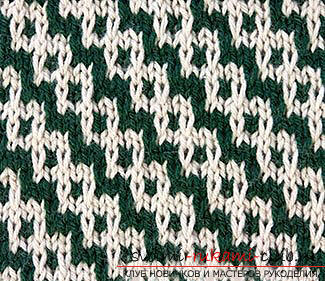 The fourth row (green thread) followsthe repeating part of the picture: three purl loops, one loop should be removed without threading it, the thread is in front of the knitting cloth, create 1 purl loops, 1 loops should be removed without tying it, the thread is in front of the knitting cloth. The fifth row (white thread): three facial loops, then there is a repeating part of the pattern: five facial loops, one loop should be removed without tying it while thread is behind the canvas, create two facial loops. Sixth row (white thread): 2nd purl loops, then repeat the part of the pattern: 1 loops need to be removed, without tying it, the thread is in front of the knitting cloth, create five purl loops. We finish the series with three purl loops. Seventh row (green thread): 1 loop should be removed without tying it while thread is behind the canvas, three facial loops, then follows the repeat of the part of the pattern: 1 the loop should be removed without tying it, the thread is behind the cloth, one one eyelet, one eyelet should be removed without tying it, the thread is behind the knitting product, create three facial loops. We finish the row: 1 the loop should be removed without tying it, the thread is behind the knitting cloth, we create one face loop. The eighth row (green thread): 1 purl loops, 1 should be removed without tying it, the thread is in front of the canvas, then the repeating part of the pattern follows: three purl loops, one loop off, without tying it, the thread is in front of the product , one back strap, one eyelet is removed, not tying it while the thread is in front of the canvas. We finish the row: 3 purl loops, 1 loop off, without tying it while the thread is in front of the canvas.
The fourth row (green thread) followsthe repeating part of the picture: three purl loops, one loop should be removed without threading it, the thread is in front of the knitting cloth, create 1 purl loops, 1 loops should be removed without tying it, the thread is in front of the knitting cloth. The fifth row (white thread): three facial loops, then there is a repeating part of the pattern: five facial loops, one loop should be removed without tying it while thread is behind the canvas, create two facial loops. Sixth row (white thread): 2nd purl loops, then repeat the part of the pattern: 1 loops need to be removed, without tying it, the thread is in front of the knitting cloth, create five purl loops. We finish the series with three purl loops. Seventh row (green thread): 1 loop should be removed without tying it while thread is behind the canvas, three facial loops, then follows the repeat of the part of the pattern: 1 the loop should be removed without tying it, the thread is behind the cloth, one one eyelet, one eyelet should be removed without tying it, the thread is behind the knitting product, create three facial loops. We finish the row: 1 the loop should be removed without tying it, the thread is behind the knitting cloth, we create one face loop. The eighth row (green thread): 1 purl loops, 1 should be removed without tying it, the thread is in front of the canvas, then the repeating part of the pattern follows: three purl loops, one loop off, without tying it, the thread is in front of the product , one back strap, one eyelet is removed, not tying it while the thread is in front of the canvas. We finish the row: 3 purl loops, 1 loop off, without tying it while the thread is in front of the canvas.  The ninth row (white thread): 1 face loop, then remove one loop, without tying it at the same time, the thread is behind the product. Then, repeat the part of the pattern: five face loops, one eyelet is removed, not tying it while the thread is behind the product. We finish the row: we create four face loops. Tenth row (white thread): four purl loops, then follows the repeating part of the picture: 1 remove the loop, without tying it, the thread is in front of the product, create five purl loops. We end the row 1 with the eyelet removed from the thread in front of the workpiece, with one backing loop. The eleventh row (green thread): two face loops, then follows the repeating part of the pattern: 1 remove the eyelet without threading it, the thread is behind the article, 1 face loop, 1 eyelet is removed without tying it, the thread is behind the cloth, three face loops. We finish the series: we remove one loops, not tying it at the same time, the thread is behind the cloth, one face loop, one eyelet is removed without tying it, the thread is behind the cloth, one face loop. The twelfth row (green thread): one backing loop, 1 remove, without tying it, the thread is in front of the canvas, again - one wrong loop, and then - one is removed without tying it while the thread is in front of the canvas. Then follows the repeating part of the picture: three purl loops, one loops are removed without tying it, the thread is in front of the cloth, one is the wrong loop, one loops are removed without tying it, the thread is in front of the canvas. We finish the row with two wrong loops. After this, repeat the pattern, beginning with the first row.
The ninth row (white thread): 1 face loop, then remove one loop, without tying it at the same time, the thread is behind the product. Then, repeat the part of the pattern: five face loops, one eyelet is removed, not tying it while the thread is behind the product. We finish the row: we create four face loops. Tenth row (white thread): four purl loops, then follows the repeating part of the picture: 1 remove the loop, without tying it, the thread is in front of the product, create five purl loops. We end the row 1 with the eyelet removed from the thread in front of the workpiece, with one backing loop. The eleventh row (green thread): two face loops, then follows the repeating part of the pattern: 1 remove the eyelet without threading it, the thread is behind the article, 1 face loop, 1 eyelet is removed without tying it, the thread is behind the cloth, three face loops. We finish the series: we remove one loops, not tying it at the same time, the thread is behind the cloth, one face loop, one eyelet is removed without tying it, the thread is behind the cloth, one face loop. The twelfth row (green thread): one backing loop, 1 remove, without tying it, the thread is in front of the canvas, again - one wrong loop, and then - one is removed without tying it while the thread is in front of the canvas. Then follows the repeating part of the picture: three purl loops, one loops are removed without tying it, the thread is in front of the cloth, one is the wrong loop, one loops are removed without tying it, the thread is in front of the canvas. We finish the row with two wrong loops. After this, repeat the pattern, beginning with the first row.
